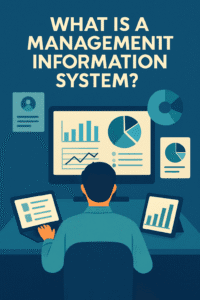Demystifying Management Information Systems (MIS): A Comprehensive Guide to Data-Driven Decision Making
In today’s fast-paced and data-saturated business world, making informed, timely, and strategic decisions is paramount to success. This is where a Management Information System (MIS) becomes a critical asset for any organization. An MIS is far more than just a software program; it’s a comprehensive framework of people, technology, and processes that work in concert to gather, process, and disseminate information, empowering managers at all levels to make better decisions, streamline operations, and achieve strategic goals.
This in-depth guide will explore the multifaceted world of Management Information Systems, from their fundamental definition and core components to their various types and profound impact on modern business. We will delve into the real-world applications of MIS across different industries, examine its benefits and challenges, and look ahead to the future trends shaping this dynamic field.
What is a Management Information System (MIS)? A Foundational Definition
At its core, a Management Information System (MIS) is a computer-based system that provides managers with the tools to organize, evaluate, and efficiently manage1 departments within an organization.2 It is a system that collects data from various sources, processes it, and presents it in a readable and accessible format. The primary purpose of an MIS is to provide timely and accurate information to support the decision-making process, enhance planning, and maintain control over organizational activities.
Think of an MIS as the central nervous system of an organization. It takes in raw data—both internal (from departments like sales, finance, and human resources) and external (market trends, competitor analysis)—and transforms it into meaningful information. This information is then delivered to the right people at the right time, enabling them to understand the health of the business, identify opportunities, and address challenges proactively.
The Core Concepts and LSI Keywords in MIS
To fully grasp the concept of MIS, it’s essential to understand its related and Latent Semantic Indexing (LSI) keywords. These terms provide a richer context and a deeper understanding of the subject. Some key related terms include:
- Information Technology (IT): The foundation upon which MIS is built, encompassing hardware, software, and networks.
- Data Management: The practice of collecting, keeping, and using data securely, efficiently, and cost-effectively.
- Business Intelligence (BI): The process of transforming data into actionable insights that inform an organization’s strategic and tactical business decisions.
- Decision Support System (DSS): A type of information system that supports business or organizational decision-making activities.
- Enterprise Resource Planning (ERP): A system that integrates all core business processes, such as finance, HR, manufacturing, and supply chain, into a single system.
By understanding these interconnected concepts, we can appreciate the holistic nature of a Management Information System and its integral role in modern business operations.
The Essential Components of an Effective Management Information System
A robust and effective MIS is comprised of five key components that work together to deliver valuable information. The absence or failure of any one of these components can compromise the integrity and usefulness of the entire system.
1. People
The human element is arguably the most crucial component of an MIS. This includes not only the IT professionals who design and maintain the system but also the end-users—the managers and employees who interact with the system to perform their daily tasks and make decisions. For an MIS to be successful, users must be properly trained and understand how to leverage the system to its full potential.
2. Data
Data is the lifeblood of any MIS. This raw, unorganized information is collected from various internal and external sources. Internal data can include sales figures, inventory levels, employee records, and financial transactions. External data might encompass market research, competitor pricing, and economic indicators. The quality and accuracy of the data are paramount; flawed data will inevitably lead to flawed information and poor decision-making.
3. Hardware
The physical components of the MIS fall under the category of hardware. This includes servers, workstations, networking equipment (routers, switches), and peripherals (printers, scanners). The hardware provides the technological infrastructure necessary to collect, process, and store data. The specifications and capacity of the hardware must be sufficient to handle the organization’s information processing needs.
4. Software
Software consists of the programs and applications that run on the hardware. This includes the operating system, database3 management systems (DBMS), and the specific MIS applications that process the data and present it to users. These applications can range from standardized reporting tools to sophisticated analytical software.
5. Business Procedures
These are the established rules and guidelines that govern how the MIS is operated, managed, and used. Procedures ensure consistency in data collection, processing, and reporting. They also dictate security protocols, access controls, and disaster recovery plans, safeguarding the integrity and availability of the information.
Unpacking the Different Types of Management Information Systems
Management Information Systems are not a one-size-fits-all solution. Different types of MIS serve different levels of management and address specific organizational needs.
1. Transaction Processing Systems (TPS)
At the operational level, Transaction Processing Systems (TPS) are used to record the day-to-day business transactions. These systems are designed to handle high volumes of routine transactions efficiently and accurately. Examples include sales order entry, payroll processing, and inventory management. The data collected by a TPS often serves as a primary input for other types of MIS.
2. Management Reporting Systems (MRS)
Management Reporting Systems (MRS) are used by middle managers to generate reports on the organization’s performance. These reports are typically based on the data collected by the TPS and are used to monitor and control the business. Examples include weekly sales reports, monthly financial summaries, and production schedules.
3. Decision Support Systems (DSS)
A Decision Support System (DSS) is a more sophisticated type of MIS that helps managers make complex, non-routine decisions. A DSS uses data and analytical models to help managers explore different scenarios and evaluate the potential outcomes of their decisions. For instance, a DSS could be used to analyze the potential impact of a price change on sales and profitability.
4. Executive Information Systems (EIS)
At the highest level of management, Executive Information Systems (EIS) provide senior executives with a high-level overview of the entire organization’s performance. An EIS typically presents information in a graphical, easy-to-understand format, allowing executives to quickly identify trends, drill down into specific areas of concern, and make strategic decisions.
5. Enterprise Resource Planning (ERP) Systems
Enterprise Resource Planning (ERP) systems are comprehensive information systems that integrate all of the key business processes of an organization into a single, unified system. An ERP system can manage everything from finance and human resources to manufacturing and supply chain management. By providing a centralized source of information, an ERP system can improve efficiency, reduce costs, and enhance collaboration across the organization. For more information on ERP systems, you can refer to resources from leading providers like SAP and Oracle.
The Paramount Importance of MIS in Modern Business
The implementation of a well-designed MIS can have a transformative impact on an organization’s performance and competitiveness. The importance of MIS in today’s business environment cannot be overstated.
Enhancing Decision-Making
This is the primary and most significant benefit of an MIS. By providing timely, accurate, and relevant information, an MIS empowers managers to make data-driven decisions rather than relying on intuition or guesswork. This leads to more effective and strategic choices that align with the organization’s objectives.
Improving Operational Efficiency
An MIS can automate many routine tasks, reducing the need for manual intervention and minimizing the risk of human error. This frees up employees to focus on more value-added activities. By streamlining business processes, an MIS can significantly improve operational efficiency and productivity.
Facilitating Planning and Control
MIS provides the data necessary for effective strategic planning. It helps managers to set realistic goals, allocate resources effectively, and monitor progress towards achieving those goals. The control function of management is also enhanced as an MIS provides regular feedback on performance, allowing for timely corrective actions.
Fostering a Competitive Advantage
In a competitive marketplace, the ability to quickly access and analyze information can provide a significant advantage. An MIS enables organizations to identify market trends, understand customer behavior, and respond to changes in the business environment more effectively than their competitors.
Improving Communication and Collaboration
A centralized MIS can break down information silos between different departments. When everyone has access to the same, up-to-date information, it fosters better communication and collaboration, leading to more cohesive and effective teamwork.
Real-World Applications and Examples of MIS
The application of Management Information Systems spans across all industries and functional areas of a business. Here are a few examples of how MIS is used in practice:
In Healthcare
In the healthcare sector, MIS is often referred to as a Health Management Information System (HMIS). These systems are used to manage patient records, schedule appointments, handle billing and insurance claims, and manage hospital resources. The World Health Organization (WHO) emphasizes the critical role of HMIS in strengthening health systems.
In Finance
The financial industry heavily relies on MIS for a wide range of functions. Banks use MIS to manage customer accounts, process transactions, and assess credit risk. Investment firms use MIS to track market trends, analyze investment portfolios, and execute trades. Financial MIS also plays a crucial role in regulatory compliance and financial reporting.
In Marketing
Marketing departments use MIS to track sales data, analyze customer demographics and preferences, and measure the effectiveness of marketing campaigns. A Customer Relationship Management (CRM) system, a specialized type of MIS, helps businesses manage their interactions with current and potential customers.
In Manufacturing
In the manufacturing industry, MIS is used for production planning and control, inventory management, and supply chain management. An effective MIS can help manufacturers to optimize their production processes, reduce waste, and ensure the timely delivery of products. The National Institute of Standards and Technology (NIST) provides resources on how manufacturing can leverage information systems.
The Challenges and Future of Management Information Systems
Despite their numerous benefits, the implementation and management of an MIS are not without challenges. These can include high initial costs, the complexity of the system, resistance to change from employees, and the ongoing need for maintenance and upgrades. Data security is another major concern, as an MIS contains a vast amount of sensitive organizational data.
Looking ahead, the field of MIS is continuously evolving, driven by advancements in technology. Some of the key future trends include:
- Artificial Intelligence (AI) and Machine Learning (ML): AI and ML are being integrated into MIS to provide more advanced analytical capabilities, automate complex tasks, and offer predictive insights.
- Big Data Analytics: The ability to analyze massive datasets will become increasingly important for gaining a competitive edge.
- Cloud Computing: More organizations are moving their MIS to the cloud to benefit from lower costs, greater scalability, and improved accessibility.
- Internet of Things (IoT): The proliferation of IoT devices will provide a new stream of real-time data that can be fed into an MIS for more granular insights and control.
Conclusion: Embracing the Power of Information
In conclusion, a Management Information System (MIS) is an indispensable tool for any organization that wants to thrive in the modern, data-driven landscape. By providing a structured framework for collecting, processing, and disseminating information, an MIS empowers managers to make more informed decisions, optimize operations, and achieve their strategic objectives.
While the implementation of an MIS requires a significant investment of time and resources, the long-term benefits in terms of improved efficiency, enhanced decision-making, and a stronger competitive position are undeniable. As technology continues to evolve, the capabilities and importance of Management Information Systems will only continue to grow, making a deep understanding of this field essential for business leaders and professionals alike. By embracing the power of information, organizations can unlock their full potential and navigate the complexities of the business world with confidence and clarity.




